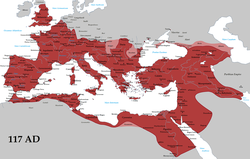Imperyong Romano
Roman Empire
| |
|---|---|
Imperial aquila
| |
 | |
 Roman territorial evolution from the rise of the city-state of Rome to the fall of the Western Roman Empire | |
| Estado | Empire |
| Kapitolyo |
|
| Relihiyon |
|
| Demonym | Roman |
| Gobyerno | Semi-elective absolute monarchy (de facto) |
• Emperor | (List) |
| Currency | Sestertius,[lower-alpha 4] aureus, solidus, nomisma |
An Imperyong Romano[17] iyo an post-Republican na estado kan suanoy na Roma asin iyo an pangkagabsan na nasasabotan tanganing mangahulogan na an peryodo asin teritoryo na pigpamayuhan kan Romans suminunod sa asumpsyon ni Octavian kan solong pagpamayo sa irarom kan Prinsipato kaidtong 31 BC. Kabali diyan an teritoryo sa Europa, Amihanan na Aprika, asin Solnopan na Asya, asin pigpamayuhan kan mga emperador. An pagbagsak kan Imperyong Solnopan na Romano kaidtong 476 conventionally minarkahan an katapusan kan classical antiquity asin an kapinonan kan Middle Ages.
Toltolan
[baguhon | baguhon an source]- ↑ 1.0 1.1 Ancient Rome: The Definitive Visual History (in English). Dorling Kindersley Limited. 2023. p. 276. ISBN 978-0-241-63575-9.
- ↑ Classen, Albrecht (2010). "The changing shape of Europe". Handbook of Medieval Studies: Terms – Methods – Trends (in English). Walter de Gruyter. ISBN 978-3-11-021558-8.
Constantine the Great transferred the capital of the Roman Empire from Rome to the newly-founded city of Constantinople
- ↑ Price, Jonathan J.; Finkelberg, Margalit; Shahar, Yuval (2022). Rome: An Empire of Many Nations (in English). Cambridge University Press. p. 19. ISBN 978-1-009-25622-3.
the capital of the Empire was transferred from Rome to Constantinople in the fourth century
- ↑ Erdkamp, Paul (2013). The Cambridge Companion to Ancient Rome (in English). Cambridge University Press. p. 202. ISBN 978-0-521-89629-0.
Constantine sounded the death knell for Rome as a vital political centre with the dedication of his new imperial capital at Constantinople
- ↑ Bjornlie, M. Shane (2013). Politics and Tradition Between Rome, Ravenna and Constantinople: A Study of Cassiodorus and the Variae, 527–554 (in English). Cambridge University Press. p. 41. ISBN 978-1-107-02840-1.
As a new capital, Constantinople provided a stage for imperial prestige that did not depend on association with the traditions of the senatorial establishment at Rome
- ↑ Coffler, Gail H. (2004). Melville's Allusions to Religion: A Comprehensive Index and Glossary: A Comprehensive Index and Glossary (in English). ABC-CLIO. p. 181. ISBN 978-0-313-07270-3.
It became Constantinople, capital of the entire Roman Empire
- ↑ Maxwell, Kathleen (2016). "Art and Diplomacy in Late Thirteenth-century Constantinople: Paris 54 and the Union of Churches". Between Constantinople and Rome: An Illuminated Byzantine Gospel Book (Paris gr. 54) and the Union of Churches (in English). Routledge. ISBN 978-1-351-95584-3.
Constantine the Great, the emperor who moved the capital of the Roman Empire from Rome to Constantinople
- ↑ Grig, Lucy; Kelly, Gavin (2012). Two Romes: Rome and Constantinople in Late Antiquity (in English). Oxford University Press. p. 237. ISBN 978-0-19-992118-8.
- ↑ Loewenstein, K. (2012). The Governance of ROME (in English). Springer. p. 443. ISBN 978-94-010-2400-6.
- ↑ Harris, Jonathan (2009). Constantinople: Capital of Byzantium (in English). A&C Black. p. 31. ISBN 978-0-8264-3086-1.
- ↑ Treadgold (1997), p. 734.
- ↑ Tricht, Filip Van (2011). The Latin Renovatio of Byzantium: The Empire of Constantinople (1204–1228) (in English). Brill. pp. 61–82. ISBN 978-9004203235.
- ↑ Bennett (1997).
- ↑ 14.0 14.1 14.2 Taagepera, Rein (1979). "Size and Duration of Empires: Growth-Decline Curves, 600 B.C. to 600 A.D". Social Science History 3 (3/4): 125. doi:.
- ↑ Turchin, Peter; Adams, Jonathan M.; Hall, Thomas D. (2006). "East-West Orientation of Historical Empires". Journal of World-Systems Research 12 (2): 222. Archived from the original on 2016-05-17. http://arquivo.pt/wayback/20160517210851/http://peterturchin.com/PDF/Turchin_Adams_Hall_2006.pdf. Retrieved on 2023-10-20.
- ↑ Durand, John D. (1977). "Historical Estimates of World Population: An Evaluation". Population and Development Review 3 (3): 253–296. doi:. http://repository.upenn.edu/cgi/viewcontent.cgi?article=1009&context=psc_penn_papers.
- ↑ Wolff, Robert Lee (1948). "Romania: The Latin Empire of Constantinople". Speculum 23 (1): 1–34, especially 2–3. doi:.
Error sa pag-cite: <ref> mga tatak na eksistido para sa sarong grupo na pinagngaranan na "lower-alpha", alagad mayong kinasungkoan na <mga pinapanungdanan na grupo="lower-alpha"/>na tatak an nanagboan, o sarong panarado </ref> an nawawara
- Mga artikulo na naglalaog nin teksto sa tataramon na Latin
- Mga artikulo na naglalaog nin teksto sa tataramon na Ancient Greek
- Pages using infobox country with unknown parameters
- Pages using infobox country or infobox former country with the flag caption or type parameters
- Pages using infobox country or infobox former country with the symbol caption or type parameters


